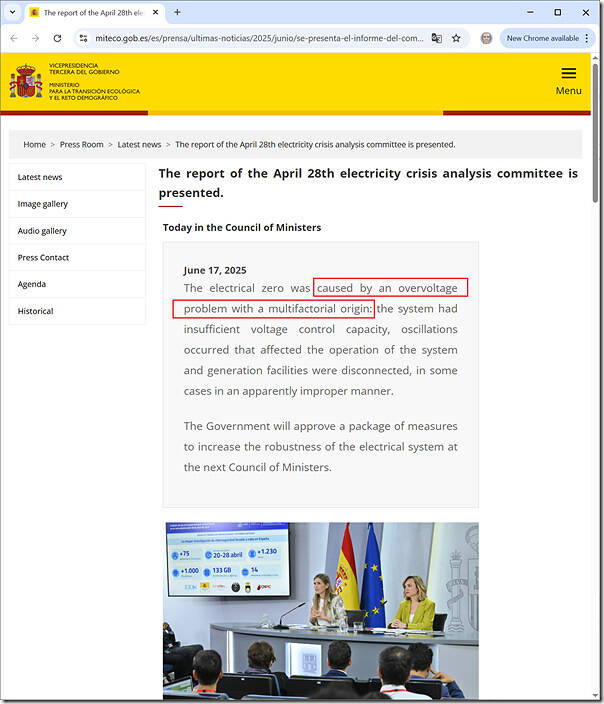Worth a quick note that (thanks firstly to Michael Caravaggio’s update on LinkedIn this morning our time) we’ve become aware that a news release has been made to suggest a report into the April 2025 power outage on Iberian Peninsula has been released.
Here’s the latest news page titled ‘The report of the April 28th electricity crisis analysis committee is presented’:
Copying in the (translated) chronology of the incident, they note:
‘The Committee has identified a sequence of events that allows for the establishment of a chronology of the incident, from which several conclusions can be drawn.
PHASE O: Voltage instability. During the days leading up to the incident, there were fluctuations in voltage, and by the morning of the 28th, voltages were fluctuating more intensely than normal.
PHASE 1: System Oscillations (12:00–12:30 p.m.). At 12:03 p.m., an atypical oscillation of 0.6 Hz was recorded, causing large voltage fluctuations for 4.42 minutes. This oscillation forced the System Operator to implement protocol-established mitigation measures, such as increasing the grid mesh—restricted by low demand—and reducing the interconnection flow with France. All of these actions mitigated the oscillation, but had the side effect of increasing voltages. At 12:16 p.m., the same oscillation was recorded again, although smaller, and at 12:19 p.m., another oscillation, of 0.2 Hz, in this case, with the usual characteristics of these European phenomena. The System Operator implemented the same mitigation measures, which also contributed to increasing voltages.
PHASE 2: Generation losses (12.32.57 – 12.33.18). Voltage began to rise rapidly and steadily, and numerous progressive disconnections of generating facilities were recorded in Granada, Badajoz, Segovia, Huelva, Seville, Cáceres, and other provinces.
PHASE 3: Collapse (12.33.18 – 12.33.30). The progressive increase in voltage produced a chain reaction of power outages due to overvoltages that could not be contained, as each disconnection contributed to further voltage increases. A drop in frequency was also recorded, resulting in the loss of synchronization with France, the tripping of the interconnection with the rest of the continent, and the peninsular electricity grid being grounded.’
And there are three main conclusions, as follows:
‘MAIN CONCLUSIONS
The Committee’s analysis of the incident allows us to conclude that the electrical failure had a multifactorial origin, in which three elements converged:
1. The system showed insufficient voltage control capacity for two reasons. First, on the 27th, prior to the incident, the System Operator scheduled the operation of 10 synchronous plants capable of regulating voltage on the 28th, according to their schedule. The final number of synchronous plants connected was the lowest since the beginning of the year.
And two, several of the plants capable of regulating voltage—and specifically compensated for it, having been programmed for this purpose due to technical restrictions—did not respond adequately to the System Operator’s instructions to reduce it; some even produced reactive power, the opposite of what was required, contributing to the problem.
2.- The oscillations occurred. The oscillations—the first of which, the atypical one, originated at a facility on the Iberian Peninsula—required modifications to the system configuration, increasing the difficulty in stabilizing the voltage. After the second oscillation, the System Operator requested the availability of a plant capable of helping regulate the voltage, but it was technically impossible to do so before the collapse.
3.- Generating plants were disconnected, some of them apparently improperly. Some of the power plant disconnections occurred before the voltage thresholds established by regulations (between 380 kV and 435 kV on the transmission grid) were exceeded, while other disconnections occurred after these limits were exceeded to protect the facilities.
Once the chain reaction began, the usual protections of the electrical system were unable to stop or contain this process. Some of these protections, such as load shedding, may have even contributed to the surge phenomenon by further discharging the lines, contributing to the rise in voltages, because they acted to compensate for the drop in generation rather than to manage the voltage.
In short, there was a lack of voltage control resources, either because they were insufficiently scheduled, or because those scheduled did not provide adequate power, or because of a combination of both, but not because of a shortage in the country; there was more than enough generating capacity to respond.’
As Michael also noted in his update:
- I also can’t confirm if the results of Google Translate (above) is accurate
- I could not actually find the report, at this point in time.
PS1 found the report … but not one translated to English (yet)
Note that we subsequently found the 182-page report as noted here.



It is interesting that overvoltage was suspected as the cause.
What are your views on the fact that there is increased solar weather activity recently (for the last few months) that could have induced voltage in power lines?
A similar event occurred in August 2003 in Northern USA and Canada, and this was also during a period of increased solar weather activity, although, according to Google’s AI, it was ruled out as being the cause.
In the higher latitudes, solar flares can alter the earth’s magnetic field which in turn can induce DC currents in transmission lines. These DC currents can cause a transmission line to trip out of service due to such currents appearing to the protection systems as earth fault currents. This has happened in Canada on very rare occassions. In Spain no transmission lines tripped until after the power system was in a system crash spiral.
In Spain the lack of power sources with voltage control incorporating stabilising circuits meant that steady state voltage oscillations
were undamped and grew to such an extent that over-voltage casued the tripping of 2 large solar PV farms that then led to the collapse.
The large amount of solar PV stations with Grid Following inverter systems that do not control system volatge but only control reactive power output according to a fixed power factor was clearly a problem.
Lots a batteries with Grid Forming Converters and voltage stabilising circuits should fix the problem.